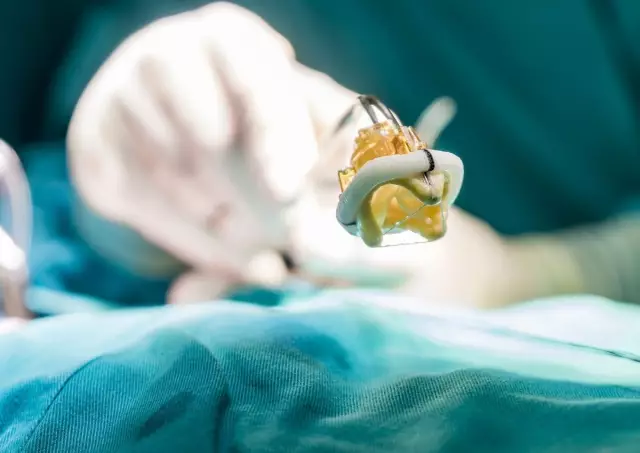- Author Rachel Wainwright [email protected].
- Public 2023-12-15 07:39.
- Last modified 2025-11-02 20:14.
Nephroptosis
The content of the article:
- Causes and risk factors
- The degree of nephroptosis
- Stages of nephroptosis
- Symptoms of nephroptosis
- Features of the course of the disease in children
- Diagnostics
- Nephroptosis treatment
- Exercises for nephroptosis
- Possible complications and consequences
- Forecast
- Prevention
Nephroptosis (kidney prolapse) is a disease characterized by the mobility of the kidney and its displacement beyond its anatomical bed. The kidney can move towards the abdominal cavity or pelvis and move downward under the influence of weight. Such mobility leads to narrowing and thinning of the vessels that approach the kidney with the subsequent development of a violation of the blood supply to the organ. The ureter may be involved in the pathological process, which leads to a retention of urine in the kidney and subsequent inflammation. More often, the pathological process affects the right kidney due to its lower location (usually two centimeters lower) compared to the left kidney.

Nephroptosis is the displacement of the kidney outside its anatomical bed
In clinically healthy people, the kidney is loosely fixed in its place of localization. When breathing, changing the position of the body, movements, it can move downward or upward. The physiological mobility of the kidney when changing the position of the body from horizontal to vertical is approximately 1-2 cm (no more than the size of the body of one lumbar vertebra). The kidney is maintained in anatomical position with fibrous and fat capsules, ligamentous apparatus. Weakening of this apparatus leads to the prolapse of the kidney. With the development of the pathological process, the kidney begins to move freely in the perineal space and descend under its weight down.
Nephroptosis often affects people aged 25-40 years, more often women due to the anatomical features of the pelvic structure. In addition, the development of the disease is facilitated by a violation of the tone of the abdominal wall, which is caused by pregnancy and childbirth.
Causes and risk factors
The main risk factors for the development of nephroptosis include:
- congenital anatomical and physiological characteristics of the body;
- significant weight loss for a short time (with diseases or diets);
- pregnancy (especially with a large fetus) and childbirth;
- injuries to the abdomen and lower back (both single and long-term or repeated regularly injury);
- excessive physical activity.
Often a combination of several causes simultaneously leads to the disease.
At risk are representatives of such professions as movers, drivers, hairdressers, surgeons, etc. - those whose activities are associated with prolonged static load.
In children, nephroptosis can occur during periods of intensive growth; improper posture and curvature of the spine are of no small importance in the occurrence of pathology. In addition, whooping cough, rickets, as well as frequent bronchitis, colitis contribute to the development of the disease.
The degree of nephroptosis
Depending on the degree of displacement of the kidney below the normal limits, three degrees of nephroptosis are distinguished, which determine the differences in the clinical picture of the disease:
- The lower pole of the kidney is lowered by more than 1.5 lumbar vertebrae.
- The lower pole of the kidney is displaced below the two lumbar vertebrae.
- The lower pole of the kidney is lowered below three or more lumbar vertebrae.

The degree of nephroptosis
According to the degree of mobility of the kidney, nephroptosis is divided into:
- motor (mobile) - the kidney takes its physiological place in the horizontal position of the body;
- fixed - the kidney is fixed in a pathological position due to the adhesive process that occurs around it.
Stages of nephroptosis
There are three main stages of nephroptosis:
- It is characterized by the exit of the lower pole of the kidney from the hypochondrium and its distinct palpation during inhalation; during exhalation, the kidney returns to its usual place.
- The entire kidney leaves the hypochondrium and is palpated in the vertical position of the patient's body, in the horizontal position the kidney returns to its normal position spontaneously or manually, rotation of the kidney around the renal pedicle may be noted; the vessels that approach the kidney are narrowed and thinned.
- Full exit of the kidney from the hypochondrium, the kidney can be displaced into the small or large pelvis.
Symptoms of nephroptosis
The disease may not manifest itself for a long time, however, during this period, irreversible changes may already occur in the body.
In its development, the disease goes through stages, each of which is characterized by specific manifestations.
At the first stage of nephroptosis, the lowered kidney is felt through the anterior abdominal wall on inhalation, and on exhalation it returns to its usual place in the hypochondrium. At this stage, there are no symptoms, or there are aching pains in the lumbar region, heaviness in the abdomen in an upright position of the body. Usually pain occurs on one side.
In the second stage, pain is more pronounced, often radiating to the abdomen, groin, genitals, thigh, and intensifies during physical exertion. In the vertical position of the body, the entire kidney falls below the hypochondrium line, but in a horizontal position it returns back on its own, or it can be returned to its normal position by hand.
For the third stage of nephroptosis, the kidney leaves the hypochondrium, regardless of the position of the patient's body. Pain sensations become more pronounced, can be noted constantly. Other symptoms of nephroptosis at this stage may be disorders of the functions of the digestive tract, renal colic, arterial hypertension. After physical exertion, patients often experience hematuria.

One of the main symptoms of nephroptosis is back pain.
The disease is accompanied by decreased appetite, nausea, constipation or diarrhea, headache, dizziness, tachycardia, insomnia. Often, patients have irritability, irascibility, emotional lability.
Bilateral nephroptosis in a late stage is manifested by symptoms of renal failure: fatigue, headaches, swelling of the extremities, accumulation of effusion in the abdominal cavity, nausea.
Features of the course of the disease in children
Nephroptosis in children is usually characterized by a low-symptom course. Patients may experience slight pain in the area of the prolapsed kidney. With physical exertion, paroxysmal pain occurs in the hypochondrium, as well as stabbing pain in the lumbar region. In some cases, with nephroptosis in children, there are swelling under the eyes, especially in the morning, as well as dysuric and dyspeptic disorders.
Diagnostics
The primary diagnosis of nephroptosis is based on data obtained during the collection of complaints and anamnesis, as well as an objective examination (with polypositional palpation).
In order to confirm the diagnosis, a laboratory and instrumental examination is carried out.
In the general analysis of urine of patients, erythrocyturia, orthostatic proteinuria, leukocyturia (with complication of pyelonephritis), as well as the presence of bacteria in the urine are determined.
Ultrasound examination of the abdominal organs, carried out in a horizontal and vertical position of the body, makes it possible to determine the localization of the kidney in different positions. Also, the method allows you to determine the presence of an inflammatory process and calculi.
Doppler ultrasound of the kidney vessels allows you to assess the indicators of blood flow, as well as the state of renal hemodynamics.
To determine the degree of prolapse of the kidney, as well as its rotation, you can use the method of excretory urography.

Ultrasound examination of the kidneys is performed while lying and standing
Spiral and multispiral computed tomography makes it possible to obtain images of the parenchyma, the renal calyx-pelvic system, and renal vessels.
To determine the displacement of the organs of the gastrointestinal tract, especially with bilateral nephroptosis, an X-ray of the stomach, esophagogastroduodenoscopy, irrigoscopy, and colonoscopy are performed.
Differential diagnosis with malignant neoplasms, renal dystopia, hydronephrosis is required.
Nephroptosis treatment
At the initial stages of the disease, nephroptosis is treated with conservative methods. Patients are shown wearing individual orthopedic devices (belts, corsets, bandages), performing a set of physiotherapy exercises to strengthen the anterior abdominal wall, as well as good nutrition. Orthopedic appliances should be put on in the morning in a horizontal position of the body while exhaling. Heavy physical exertion should be avoided.
In the later stages of nephroptosis, surgery may be required. First of all, the operation is indicated for patients with intense pain, as well as with the development of complications of nephroptosis.
The main goal of the surgery is to return the kidney to its normal position with fixation to the adjacent anatomical structures. After surgery (traditional nephropexy, nephropexy according to the Rivoir method, laparoscopic nephropexy), bed rest is shown for two weeks. Surgical treatment of nephroptosis is not recommended for elderly patients, with prolapse of the abdominal organs, as well as with severe concomitant pathologies.

One of the methods of surgical treatment of nephroptosis is nephropexy according to the Rivoir method
With the development of nephroptosis during pregnancy, regular monitoring of the patient's condition is necessary. The disease is not a contraindication to pregnancy. Therapy of nephroptosis in pregnant women is primarily aimed at relieving pain, the main treatment of the disease is carried out after childbirth.
Exercises for nephroptosis
Physiotherapy is one of the most important components of conservative treatment for nephroptosis. Specially selected exercises allow the kidney to return to the renal bed in the early stages of the disease and / or prevent its further descent. It is necessary to perform physiotherapy exercises daily. Do not engage in therapeutic exercises immediately after eating.
The selection of exercises for nephroptosis is carried out individually by a specialist. The following exercises are often prescribed:
- lifting the lower limbs on inhalation, returning to the starting position on exhalation (carried out in a horizontal position of the body);
- alternate bending of the legs at the knee on inhalation, returning to the starting position on exhalation (carried out in a horizontal position of the body with a small roller under the back);
- leg movements imitating cycling (performed while lying on your back);
- lifting a straight leg up, alternately both legs (carried out lying on one or the other side);
- arching of the back (carried out in the knee-elbow position).

Exercise bike is beneficial for nephroptosis
Possible complications and consequences
Nephroptosis can be complicated by the development of the following pathological conditions:
- ischemia of the kidney;
- venous (less often arterial) hypertension;
- pyelonephritis;
- hydronephrosis;
- nephrolithiasis;
- fornical bleeding.
Forecast
With timely diagnosis and properly selected treatment, the prognosis for life is favorable, but there is a need to avoid activities associated with heavy physical exertion, as well as a long stay in an upright position.
If untreated, the prognosis is poor. Over time, the patient develops complications, the progression of the pathological process leads to disability.
Prevention
In order to prevent the development of nephroptosis, it is recommended:
- timely examination by a doctor after injuries and / or pain in the lumbar region;
- wearing a bandage during pregnancy;
- women in the postpartum period should do exercises aimed at strengthening the abdominal muscles;
- the formation of the correct posture in children.
YouTube video related to the article:

Anna Aksenova Medical journalist About the author
Education: 2004-2007 "First Kiev Medical College" specialty "Laboratory Diagnostics".
The information is generalized and provided for informational purposes only. At the first sign of illness, see your doctor. Self-medication is hazardous to health!






